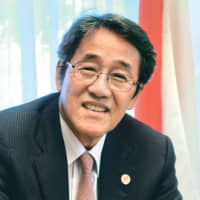Vietnam’s unprecedented economic growth has captured the world’s attention. Foreign direct investment (FDI) reached $19.1 billion in 2018 — a 9.1 percent increase compared with the previous year.
With a stable political landscape, gross domestic product growth of 6.8 percent and strong export figures, investor confidence in the Southeast Asian country is stronger than ever.
With $8.6 billion worth of FDI approvals in Vietnam last year, Japan is the largest investor in the country. Bilateral relationships between the two countries are also at an all-time high.
“The relationship has rapidly strengthened due to three main reasons,” said Japanese Ambassador to Vietnam Kunio Umeda.
“The first is that the importance of Vietnam has been increasing for Japan in terms of security. Both Japan and Vietnam share fundamental maritime principles that are important in the South China Sea, one of the most important sea-lanes for Japan. The second reason is that Vietnam is helping to ease Japan’s very serious labor shortage; more than any other country. Currently, around 300,000 Vietnamese people live and work in Japan. The number of Vietnamese ‘technical trainees’ is the largest among foreign workers and the number of Vietnamese students is the second largest after China. The third reason is that more and more Japanese companies are investing in and establishing bases in Vietnam, with over 3,200 Japanese companies having established bases in Vietnam.”
According to the Japan External Trade Organization (JETRO), over half of the Japanese enterprises highly appreciate Vietnam’s market scale and growth potential, stable political and social situation, and low labor costs.
“Until five or six years ago, the main purpose of Japanese investments in Vietnam was to establish export bases for manufacturing companies,” said Umeda.
“Since then, the objective of investments has been changing. Recently, the main objective of investments is to meet Vietnam’s increasing domestic demand, which is rapidly expanding.”
Hironobu Kitagawa, chief representative of JETRO Hanoi, shares this notion.
“Generally, there is an image that Vietnam is a country in which the manufacturing industry invests. However, in recent years Japanese companies have advanced to Vietnam’s tertiary and service industries,” said Kitagawa.
“When comparing the number of new licenses in 2017 by industry, the percentage for the manufacturing industry is 24 percent, whereas the proportion for tertiary industries is 67 percent. In terms of the scale of companies, 90 percent of new investment projects are from small to medium-sized firms (less than $5 million). The situation has changed from ‘Vietnam is a major investment destination for the manufacturing industry,’ which was how the country was viewed in the past.”
The Vietnamese population’s purchasing power is increasing and middle-income household spending is on the rise. Within the tertiary sector, retail, health care, education and real estate are key areas in which Japanese companies are investing. As with many developing economies, one of the challenges foreign investors are facing in Vietnam is the rising cost of labor.
“Through the introduction of automation combined with the right education and technical training, as well as the development of rural areas, manufacturers can continue to prosper in Vietnam,” said Koji Takimoto, chief representative of JETRO Ho Chi Minh City.
“The Vietnamese workforce is still very young and they are willing to learn new skills. In the next decade or so, with the help of Japanese investment, I believe Vietnam has the potential to compete with the more developed countries in Southeast Asia,” Takimoto added.





